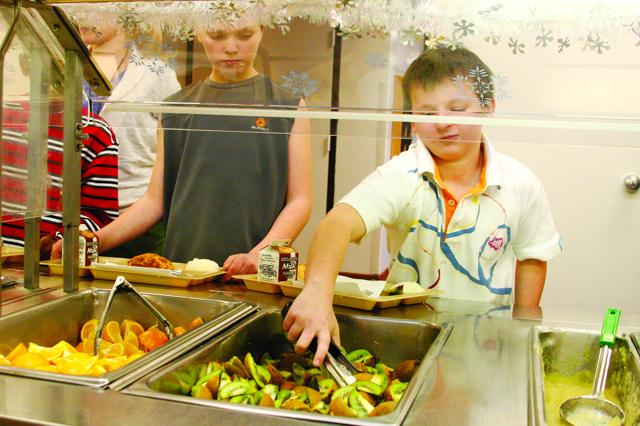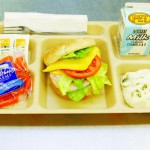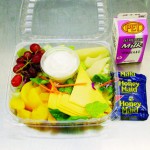- Can you spell “kiwi”? Despite a host of challenges — from budget constraints to matching what kids like to eat — local schools feed thousands of kids every day. photos by Jonathan Welch
- Box lunch: Buncombe County school lunches do try to expose kids to healthier foods.
The statistics are hard to ignore. In Buncombe County, 28 percent of kindergartners — and 39 percent of fifth-graders — are overweight.
New U.S. Department of Agriculture guidelines released this month propose the first major nutritional overhaul of school lunches in 15 years. Based on recommendations by the nonprofit Institute of Medicine, these guidelines would reduce the sodium and fat allowed in school meals while specifying new levels of required nutrients. If approved, these rules would be mandatory for schools receiving federal meal-program reimbursements.
But for local schools, it’s a difficult balancing act. Tight budgets and limited preparation time in school kitchens make serving nutritious and appealing meals a continuing challenge, and the new guidelines will further raise the bar.
Lynette Vaughn-Hensley, director of Child Nutrition Services for the Buncombe County Schools, says the system’s meals already meet many of the objectives outlined in the new guidelines. "We don't have fryers; we don't drop our chicken nuggets in grease — they're baked. If you see French fries on the menu, it's because that's the common terminology — but it's really baked fries."
Apparently, however, that depends on how you look at it. Tim Pierce, the cafeteria manager at Haw Creek Elementary, says many items favored by the kids he serves are fried and frozen at the factory before being baked in the school kitchen. Asked about the apparent discrepancy, Vaughn-Hensley explains: "The product we get is USDA-approved for child nutrition. We don't fry anything."
Semantics aside, it's been a difficult road in recent years. "No Child Left Behind left behind child nutrition," she asserts, referring to the 2001 legislation that she says increased classroom instructional time, potentially at the expense of physical activities kids once used to burn up calories. "They left us out of the mix."
So the schools do the best they can. "There's no need to peel potatoes," she says, because when it comes to rehydrated mashed potatoes, "the product that's out there is excellent." And in addition to processed foods, "We are exposing our students to a diversity of fresh fruits and vegetables. The parents may not be able to afford it [at the grocery store], but when kids see a kiwi, they know what that is."
A look at a typical Buncombe County school lunch generally bears this out. The turkey-and-cheese sandwich offered on the day Xpress visited Haw Creek came on whole-wheat bread with fresh tomato and lettuce, with a side of kiwi and orange wedges, plus baby carrots with ranch dressing.
"Children will eat anything if it's dipped in ranch," Vaughn-Hensley says with a grin, adding that the apples in the cafeteria are locally grown. "We want everything locally that we can get," she reports.
Complicating factors
Liability issues limit the options, however: Fresh produce must be certified for so-called good agricultural practices, which cover things like proper food handling and using safe water sources. "We can't just go to the farmers market and fill the truck with whatever — I have to hold a vendor responsible and accountable," Vaughn-Hensley explains.
Economics also contributes to the rise in local childhood obesity — in various ways. Lower-income people are overrepresented among the obese, and since schools are in session only 180 days a year, families are the primary meal providers. "Most families can't afford to buy all the fruits and veggies they might like," she notes.
At the same time, thanks to the troubled economy, growing numbers of local students now receive subsidized meals. Last year, 52 percent of students in the county schools qualified for a free or reduced-price lunch; that's up from 42 percent in 2007, and 32 percent in 2002. In other words, there are more financially challenged local families at risk of childhood obesity.
Meanwhile, some local school cafeterias have to feed as many as 1,000 youngsters while meeting USDA dietary guidelines. For a full-price $2 school lunch, Vaughn-Hensley reveals, “We get 26 pennies reimbursed by the USDA. At the same time, food costs have gone up. Child Nutrition Services has to pay all its own bills — it's a standalone corporation. Why doesn't the USDA tell us what to serve and then fund it?" she asks with obvious frustration. Food sales are the program’s main source of income: Ironically, subsidized meals are reimbursed at a higher rate ($2.32 for reduced-price lunches; $2.72 for free ones).
“No matter what happens with cost,” she continues, “we have to come up with a healthy menu. We're doing a great job: Our mission is healthy kids who graduate. We don’t intend to back down at all.”
The USDA is seeking public comment on its proposed child-nutrition guidelines through Wednesday, April 13. For more info or to submit comments, go to http://bit.ly/hT6Dug.
— Susan Andrew can be reached at 251-1333, ext. 153, or at sandrew@mountainx.com.







Everything is this article is true. USDA mandates things and then never gives enough funding. If students won’t eat what is put out we are in a catch 22 situtations. Guidelins are great if you don’t have to implement them. Also lets remember we still have 70% of kids needing 1/3 of the daily calories we provide. We have reduced fat, sat. fat, trans fat, salt, and sugar allready. Just exactly what can we give them to meet the appx. 800 calories they need. If anyone has the answers I’ll be happy to work with you.
The worst culprit many feel is the artificially hydrogenated fats. Created in labs to make food last longer on the shelf, it is in darn near everything these days. Apparently the body can’t process it well. Research not funded by the industry is increasingly showing it to be a problem. I don’t know how the cafeterias get around it, with their budgets, other than the various local foods/produce in schools programs. 40 percent of 5th graders, or 2 out of 5 kids, that’s sad. It’s one thing to have some extra padding, another to be obese. That hurts kids in many ways.